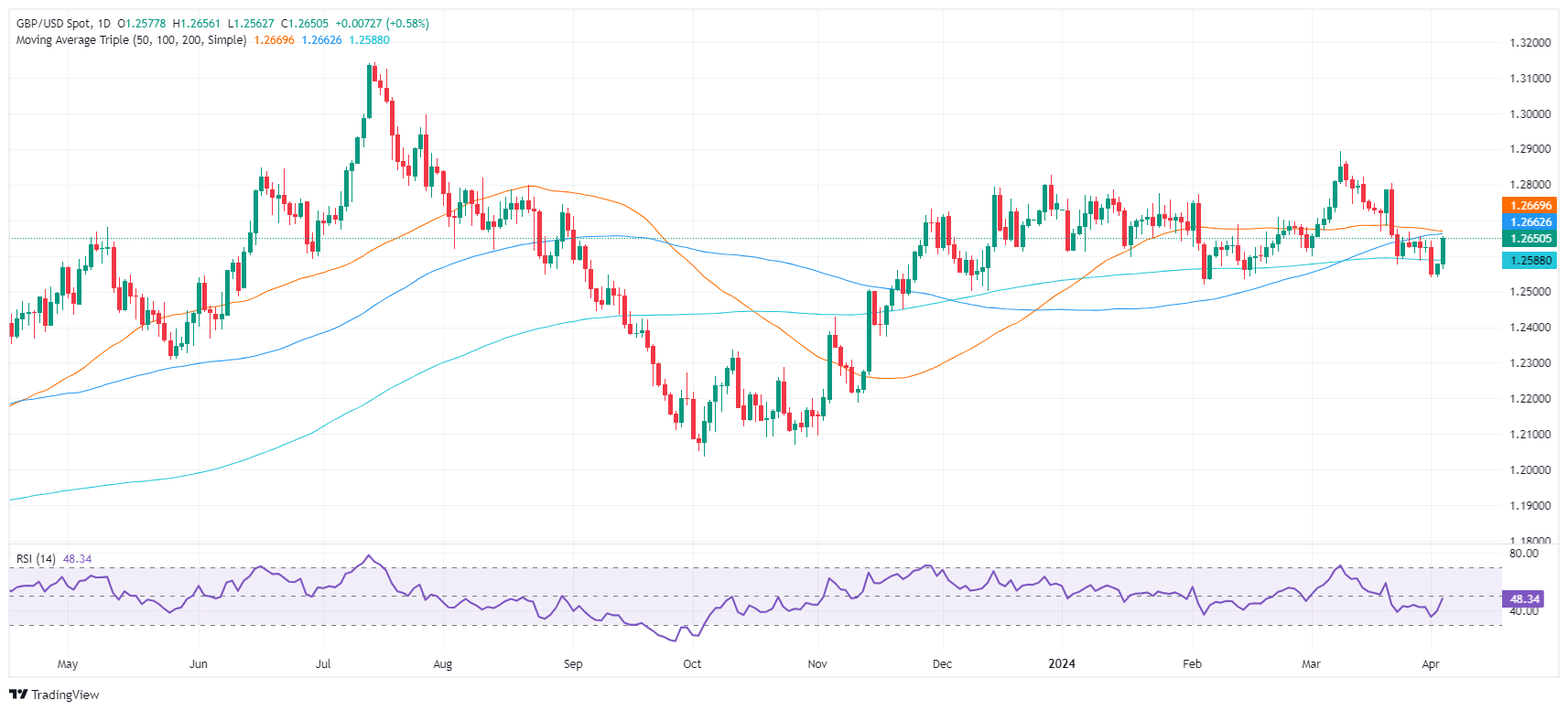- GBP/USD rises to 1,264, boosted by dollar weakness, dovish signals from the Fed, and weak services data.
- Jerome Powell Links Rate Cuts to Data; Raphael Bostic hints that the cuts will be delayed until the end of 2024.
- Changes in BoE and Fed rate cut expectations indicate an evolution in monetary policies.
The British pound posted solid gains against the dollar on Wednesday, after bouncing from a seven-week low of 1.2539 on Tuesday. Federal Reserve officials made statements and weaker-than-expected US services sector data were a headwind for the US dollar, which fell for the second day in a row. The GBP/USD pair is trading at 1.264 and gaining 0.56%.
GBP/USD rebounds from lows as comments from Fed officials and US services data influence currency dynamics
The Institute for Supply Management (ISM) showed a softer-than-expected services PMI, along with Fed Chair Jerome Powell reaffirming that interest rates would be cut, but that it would depend on upcoming data. In contrast, Atlanta Fed President Raphael Bostic maintained his stance of a single rate cut, adding that it could occur in the last quarter of 2024.
Meanwhile, US Treasury yields pared their earlier gains, a headwind for the Dollar. The US Dollar Index (DXY), which tracks the evolution of the North American currency against six other currencies, falls 0.46% and stands at 104.26 points. This comes after the release of the ISM Manufacturing PMI, which pushed the DXY up to 105.00.
Bank of England and Fed rate cut expectations
Money market futures traders see the Bank of England (BoE) cutting rates by 25 basis points in June, with odds of 66%. On the other side of the Atlantic, traders had priced in a 25 basis point cut by the Fed until July 31.
GBP/USD Price Analysis: Technical Outlook
Considering the fundamental backdrop, the GBP/USD price action suggests that the pair could test the 50-day moving average (DMA) after reclaiming the 100 and 200 DMA, each at 1.2586 and 1.2656, respectively. If these levels are exceeded, we will have to expect new increases around 1.2700. On the other hand, if the sellers intervene and push the exchange rate below the 200-DMA at 1.2586, a test of 1.2500 could occur.

Pound Sterling FAQ
What is the Pound Sterling?
The British Pound (GBP) is the oldest currency in the world (886 AD) and the official currency of the United Kingdom. It is the fourth most traded currency unit in the world, with 12% of all transactions and an average of $630 billion per day, according to 2022 data.
Its key currency pairs are GBP/USD, also known as “Cable”, which represents 11% of the forex market, GBP/JPY, or the “Dragon” as it is known to traders (3%), and EUR/GBP (2%). The pound sterling is issued by the Bank of England (BoE).
How do Bank of England decisions influence the Pound Sterling?
The most important factor influencing the value of the Pound Sterling is the monetary policy decided by the Bank of England. The Bank of England bases its decisions on achieving its main objective of “price stability”, that is, a stable inflation rate of around 2%. Its main tool to achieve this is the adjustment of interest rates.
When inflation is too high, the Bank of England tries to contain it by raising interest rates, which makes access to credit more expensive for individuals and companies. This tends to be positive for the GBP, as higher interest rates make the UK a more attractive place for global investors to park their money.
When inflation is too low, it is a sign that economic growth is slowing. In this scenario, the BoE will consider lowering interest rates to make credit cheaper, so that companies borrow more to invest in projects that generate growth.
How does economic data influence the value of the Pound?
The published data gauges the health of the economy and may influence the value of the Pound sterling. Indicators such as GDP, manufacturing and services PMIs, and employment can influence the direction of the Pound.
A strong economy is good for the British pound. Not only does it attract more foreign investment, but it may encourage the Bank of England to raise interest rates, which will directly strengthen the Pound. Otherwise, if economic data is weak, the pound is likely to fall.
How does the trade balance affect the Pound?
Another significant data for the pound sterling is the trade balance. This indicator measures the difference between what a country earns from its exports and what it spends on imports during a given period.
If a country produces highly sought-after exports, its currency will benefit exclusively from the additional demand created by foreign buyers wishing to purchase these goods. Therefore, a positive net trade balance strengthens a currency and vice versa for a negative balance.
Source: Fx Street
I am Joshua Winder, a senior-level journalist and editor at World Stock Market. I specialize in covering news related to the stock market and economic trends. With more than 8 years of experience in this field, I have become an expert in financial reporting.







